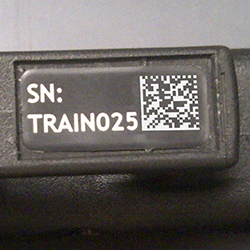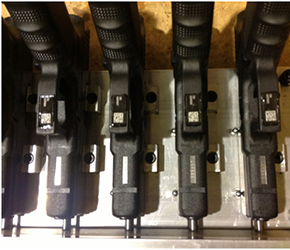For the first time in more than 40 years, the United Kingdom Ministry of Defence (UK MoD) granted a new standard issue handgun for British forces. The Glock G17 9mm pistol replaced the Browning 9mm pistol, which was in service since 1967. The Glock was found to be lighter, faster, more accurate and had a larger magazine capacity than the Browning. For these reasons, it was important to get the pistols into the field quickly and efficiently. However, prior to distribution, each Glock must be uniquely identified.
To improve efficiencies in military asset management and visibility, the UK MoD developed a Unique Identification (UID) policy to uniquely mark and identify specific ranges of dismounted close combat equipment within the defence inventory.

Under the UID policy, marks or labels containing two-dimensional (2D) UID
As the UK MoD’s UID Enabling Contract holder, Camcode Global was tasked with assisting the UK MoD to establish a method for identifying, tracking and managing its entire inventory of Glock G17 pistols prior to deployment.
Objective:
To ensure its Glock G17 pistols were identified and ready for deployment, the UK MoD mandated that all Glocks must be tracked through UID bar codes. The goal of the UK MoD’s Glock identification initiative was to mark 32,000 Glock G17 pistols at the depot receiving the weapons as quickly and efficiently as possible.
Challenges:
The primary challenge in uniquely identifying and labeling Glock G17 pistols is the design of the pistol itself. The Glock’s lower receiver is manufactured from a polymer/composite material, which has a lower surface energy that makes label adhesion difficult.
In addition, the area to be marked is subject to repeated impact and abrasion. There is also little room to place a label on the surface of the Glock. The Camcode Global engineering team evaluated other marking options, including direct part marking, but determined that direct part marking on the polymer did not produce a proper contrast that could be read with UK MoD preferred scanners.
Another issue facing Camcode Global was the need to track the locations of each pistol during both storage and transport.
Solutions:

Camcode Global developed a custom marking solution for the Glock G17 pistol. The process began by laser engraving a recess on the pistol’s trigger guard. Next, a pre-encoded photosensitive aluminum UID label was encapsulated within a clear epoxy on the trigger guard underside for protection from impact, abrasion and shear forces.
To mark the Glocks quickly and efficiently, Camcode Global created a custom aluminum jig that permitted 10 pistols to be laser-etched simultaneously. The UID labels were applied within the laser-etched recessed area and coated with a clear epoxy, which was UV-cured within seconds after application. Labels were then scanned and entered in the UK MoD item registry and the Glocks were repackaged and ready for deployment.
To complete the entire marking task, Camcode Global’s developed a streamlined procedure to unpack and fixture the pistols in place for marking, laser-etch the pistols, apply the UID labels and epoxy, then scan and package each.
Results:
Cycle time, or the pace of marking the pistols was reduced to less than two minutes per pistol as a result of the custom jig.
In addition to marking the Glock itself, Camcode Global devised a solution to mark each box in which the Glock is housed and transported. When shipping the newly-marked Glock from the depot for the first time, the UK MoD simply scanned the external label in order to track the locations of the pistols within each box.
Upon completion of the project, all 32,000 Glock pistols were marked and registered in the UK MoD database. This allows the UK MoD to track and manage every Glock in the field throughout each weapon’s lifecycle.
